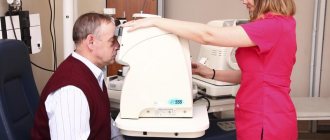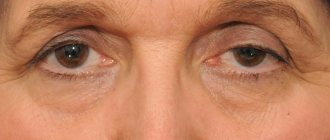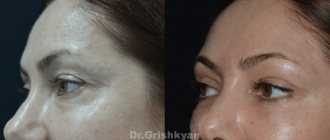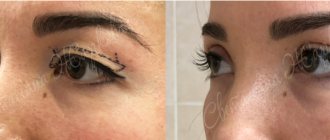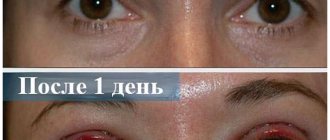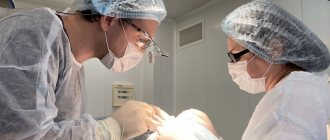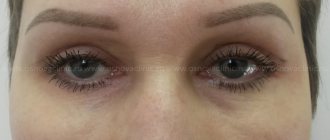Any plastic surgery is a complex procedure, and in each specific case the body may react differently to the intervention. Blepharoplasty is one of the most delicate and complex operations, since the surgeon must not only correct existing age-related changes in the eyelids, but also ensure the aesthetic appearance of the periorbital area without disturbing the aesthetic proportions of the face.
Unsuccessfully performed blepharoplasty can change the face beyond recognition, give the look a sad look, change the shape and shape of the eyes. It must be said that it is often very difficult to correct the changes that have arisen and this requires a number of reconstructive operations.
So what are the signs that indicate unsuccessful blepharoplasty:
- Noticeable scars (high on the upper eyelids and low on the lower eyelids)
- Failure to close eyelids due to deficiency of upper eyelid skin (short upper eyelids)
- Ectropion (shortening of the lower eyelid), the appearance of a strip of sclera under the iris
- Dry eyes, watery eyes
- Eversion of the lower eyelid
- Appearance of scar epicanthus at the inner corner of the upper eyelid
- Presence of residual “hernias” of the eyelids
- Deformation of the shape and size of the palpebral fissure (“round” eye)
“ROUND EYES” EFFECT
The most common mistake that an inexperienced surgeon can make when performing blepharoplasty is to excise too much skin of the lower eyelid. As a result, the so-called “round eye effect” occurs: the eyes look unnaturally bulging, and in the worst case, they do not even close completely. Needless to say, such an effect not only completely spoils the impression of the operation, but also significantly complicates the patient’s life.
Such patients develop watery eyes, dryness and redness of the eyes, and conjunctivitis often occurs. The eyes have an unnatural, “operated” appearance.
Eye asymmetry after blepharoplasty: reasons for its appearance
After the operation, certain complications may occur, one of them is eyelid asymmetry. This phenomenon is quite exciting for the patient and is a reason to contact a doctor. Asymmetry is often caused by changes in eyelid alignment or shape. It is worth noting that this situation can be characterized both as a normal phenomenon and as a complication. Let's find out the possible causes of the defect.
Let us say right away that eye asymmetry after surgery is not such a rare occurrence. After blepharoplasty, many patients note that one eye becomes narrower and the other wider. The cause of an external defect may be changes in tissues, both reversible and not. One of the most common causes is swelling after blepharoplasty. After surgery, swelling can persist for up to six months, depending on the individual characteristics of the body.
The difference in the eyes after surgery is due to uneven accumulation of fluid in the eyelid area. In this case, it seems that the eyelids are located at different heights, and the incision on one side is narrower than on the other. In this case, the defect will disappear as the swelling subsides. Unfortunately, not all reasons are so safe. There are a number of factors that can lead to asymmetry, requiring surgical intervention or additional correction.
Here are the main ones:
- Incorrect structure of the facial part of the skull, both bone structure and soft tissues. In this case, most likely, the asymmetry appeared before blepharoplasty, and after the operation it became more noticeable.
- It is possible that the operating doctor made a mistake during the correction. Not enough or too much skin has been removed, or tendons or muscle fibers have been damaged. Perhaps the stitches were placed incorrectly.
- Ptosis of the upper eyelids. After surgery, due to swelling, ptosis will in any case be present, but with normal rehabilitation it should gradually disappear. If, six months after the operation, the defect has not disappeared, an operation will be required to remove it;
- The presence of rough scars that change the shape of the palpebral fissure or tighten the tissue of the eyelids. It is worth noting that in some cases, the difference between the height of the eyelid folds directly depends on which hand the doctor has the main one. It has been noticed that right-handed people make a more accurate cut on the right side, and vice versa on the left. However, if the scars heal properly, you will not notice any negative consequences, the eyelids will have an ideal appearance.
- With an uneven division of facial expressions, in the case when on one side the muscles are more developed and on the other less. In this case, the peculiarity could have been present in the patient before the operation, but it could also arise as a complication during the rehabilitation period.
REPEATED BLEPHAROPLASTY
However, there is no need to panic in any of these cases. If you have undergone blepharoplasty and it was unsuccessful, in any modern clinic you will be offered a repeat operation. Repeated intervention will help correct inaccuracies made during the initial procedure and provide the result that you originally expected.
The only difficulty is to find a specialist whom you really trust. Because after an unsuccessful operation, patients are usually afraid of repeated failure. Collect information about different clinics, look at reviews of the work of the most famous surgeons, talk with friends who have undergone plastic surgery and are satisfied with the result.
On the website in the appropriate section you can find real patient stories with attached photographs before and after the procedure. And, of course, the surgeon himself will help to fully clarify the situation during an individual consultation.
What to do if you have eye asymmetry after blepharoplasty
Rehabilitation after eyelid correction is different for everyone, it depends on the complexity of the correction performed and the patient’s body. If you follow all the recommendations of your doctor, this period will pass quickly and painlessly. There is a certain algorithm of actions during the recovery period, which has been practiced in many clinics for many years. However, remember that each case is individual, and your doctor may make adjustments to the general recommendations.
The first 2 weeks after blepharoplasty
We strongly recommend that you do not look at yourself in the mirror immediately after surgery. The presence of edema can significantly spoil the mood and drive a weak-nervous patient to despair. Remember, this phenomenon is temporary, swelling tends to disappear slowly and unevenly. Pronounced bruises are also a common occurrence after blepharoplasty. Seams on the eyelids located at different levels can emphasize the asymmetry of the eyes. All these phenomena are not a reason to panic; you should be patient until the physiological changes take place naturally.
Factors that can cause uneven swelling:
- lifting weights;
- work in an inclined position;
- individual characteristics of the location of lymphatic vessels and veins, which are responsible for the outflow of excess fluid from tissues;
- uneven tissue injury, which contributes to the presence of greater swelling on one side of the face;
- sleeping on your side or back;
- failure to maintain drinking balance during the rehabilitation period
2-3 weeks after blepharoplasty, swelling begins to subside. In this case, the eyelids, ideally, should become even. However, the palpebral fissures will not immediately become symmetrical. If you observe a trend in which the right eye becomes similar to the left, the ridges and folds in the eyelid area are smoothed out, and excess water gradually disappears - the recovery process is proceeding normally, and there is no reason to panic. It is worth being as patient as possible and letting the rehabilitation process take its natural course.
div id=”content_rb_84609″ class=”content_rb” data-id=”84609″>
The cost of repeated blepharoplasty at the Doctor Grishkyan plastic surgery clinic in Moscow.
Blepharoplasty (eyelid surgery) cost of surgery
| Operation name | Cost in rubles |
| Upper eyelid surgery | 160000 |
| Lower eyelid surgery | 160000 |
| Blepharoplasty of the upper and lower eyelids | 250000 |
| Volume plastic surgery of the upper eyelids (upper eyelid surgery + lipofilling) | 180000 |
| Volume plastic surgery of the lower eyelids (Lower eyelid surgery + lipofilling) | 180000 |
| Transconjunctival blepharoplasty of the lower eyelids (author's technique) | 180000 |
| Repeated blepharoplasty of the upper eyelids, correction of complications after eyelid surgery by another surgeon | 210 000 |
| Repeated lower eyelid blepharoplasty, correction of complications after eyelid surgery by another surgeon | 210 000 |
Can there be complications after upper blepharoplasty?
Blepharoplasty is one of the safest operations on the face, since it does not affect the eyeball at all - the effect is only on the skin and subcutaneous fat layer of the eyelid.
But this safety and naturalness of the result are possible only if the operation is performed by an experienced surgeon who in no case tightens the skin or excises excess.
A negative result can most likely be considered not as complications, but as an incorrect calculation, that is, the result of an operation when more skin is cut off than necessary.
Then the eyeball turns out to be open - hence the effect of bulging “owl” eyes (when the eyelid does not close the white of the eyelid well and the shape of the eye becomes round), when the shape of the eyes changes the entire face for the worse.
Complications during blepharoplasty and methods for their correction
Repeated blepharoplasty - lipofilling of the upper eyelid was performed in order to recreate the mendala-shaped eye shape lost after blepharoplasty.
An unsuccessful surgical intervention entails disappointment and dissatisfaction for the patient. Negative aesthetic results and varying degrees of complications of blepharoplasty completely negate the original goal of rejuvenating eyelid surgery. The problems that arise after unsuccessful lower and upper blepharoplasty differ radically.
Complications after upper eyelid blepharoplasty
When performing upper eyelid surgery, the surgeon makes an incision at the level of the skin fold of the upper eyelid. Thus, to hide the scar in the natural crease of the eyelid. What is important is that she remains invisible to the gaze of others. The operation involves excision of excess fat on the upper eyelid, straightening and removal of fatty hernias. Among the most common complications of upper eyelid blepharoplasty, experts note:
- Excessive excision of skin. In most patients, the skin stretches spontaneously after a short period of time. In some cases, the patient is prescribed injections of a special drug that provokes stretching;
- Insufficient skin excision. In this case, there is no way to do without a repeat operation to remove excess skin tissue;
- Excessive removal of fatty tissue (so-called fatty hernias). The error entails a complication in the form of skeletonization of the upper eyelids. The deficiency can be corrected using the lipofilling method.
Complications after lower eyelid blepharoplasty
A complication in this case is excessive removal of fatty tissue (hernias) during the first blepharoplasty.
Ptosis (the lower eyelid is excessively taut downwards). This complication of lower eyelid blepharoplasty occurs due to excessive removal of skin under the eyes. The correction can be carried out in two ways. The surgical method involves performing canthopexy (its goal is to strengthen the outer edges of the lower eyelids). To improve the aesthetic effect, our specialists usually complement this operation with lipofilling of the outer corners of the eyes, which creates a supportive cushion. The second method is medicinal, when the skin is stretched using special drugs. Elimination of the defect using medications. Treatment can begin no earlier than 6 months after unsuccessful blepharoplasty.
Will your face change after blepharoplasty?
All manipulations performed during blepharoplasty do not change the facial expression in any way, they simply give facial expressions greater lightness and freedom, rejuvenate and refresh the face.
According to our patients, most friends and acquaintances, meeting them after eyelid surgery, say that they look very good, completely unaware of the fact of the operation.
An experienced plastic surgeon, excising excess skin, opens the eye in such a way that the look is natural, the eyeball is not exposed, and the eyelids close naturally.
